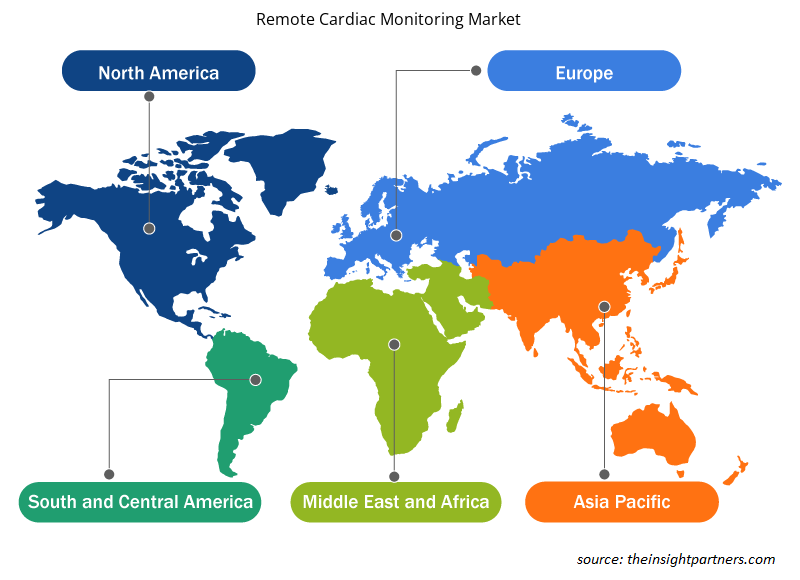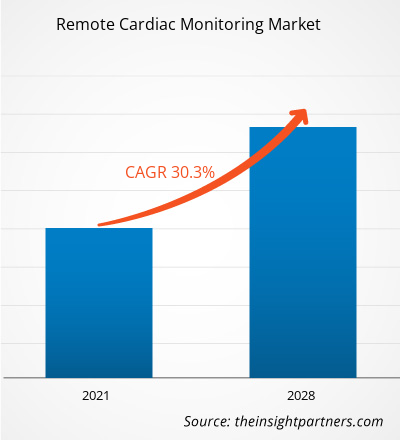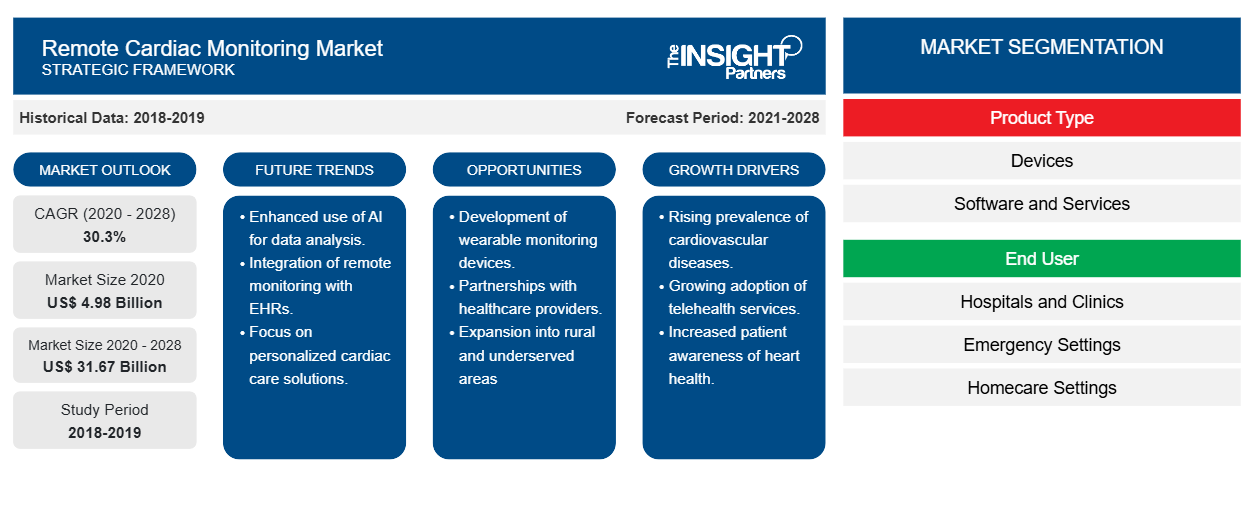Si prevede che il mercato del monitoraggio cardiaco remoto raggiungerà i 31.671,69 milioni di dollari entro il 2028, rispetto ai 4.976,40 milioni di dollari del 2021; si stima che crescerà a un CAGR del 30,3% dal 2021 al 2028.CAGR of 30.3% from 2021 to 2028.
I dispositivi di monitoraggio cardiaco remoto consentono un monitoraggio continuo delle attività elettriche del cuore lontano dagli ospedali. Consentono inoltre il monitoraggio elettrocardiografico (ECG) a domicilio di pazienti con sospette aritmie cardiache o a rischio di sviluppare aritmie. Il monitoraggio può essere eseguito anche quando i pazienti sono immersi nelle loro attività quotidiane. Pertanto, uno dei vantaggi più importanti del monitoraggio cardiaco remoto è che riduce la necessità di visite mediche di routine. Dispositivi come pacemaker e defibrillatori cardioverter impiantabili vengono impiantati nel cuore dei pazienti tramite procedure minimamente invasive. Un trasmettitore che funziona in sincronia con il dispositivo esegue la trasmissione dei dati. Fattori come l'aumento dell'incidenza delle malattie cardiovascolari (CVD) e i continui sviluppi nell'approccio della telemedicina stimolano la crescita del mercato del monitoraggio cardiaco remoto . Tuttavia, le preoccupazioni relative alla privacy dei dati ostacolano la crescita del mercato.electrocardiographic (ECG) monitoring of patients with suspected cardiac arrhythmias or at risk for developing arrhythmias. The monitoring can also be performed when patients are engulfed in their day-to-day activities. Thus, one of the most important benefits of remote cardiac device monitoring is it decreases the need for routine doctor visits. Devices such as pacemakers and implantable cardioverter-defibrillator are implanted in the heart of the patients through minimally invasive procedures. A transmitter that works in sync with the device undertakes the transmission of data. Factors such as increase in the incidence of cardiovascular diseases (CVDs) and continuous developments in the telemedicine approach boost the growth of the
Personalizza questo report in base alle tue esigenze
Riceverai la personalizzazione gratuita di qualsiasi report, comprese parti di questo report, o analisi a livello nazionale, pacchetto dati Excel, oltre a usufruire di grandi offerte e sconti per start-up e università
-
Scopri le principali tendenze di mercato in questo rapporto.Questo campione GRATUITO includerà analisi di dati che spaziano dalle tendenze di mercato alle stime e alle previsioni.
Approfondimenti di mercato
Aumento dell'incidenza delle malattie cardiovascolari
Il monitoraggio remoto dei pazienti (RPM) consente ai pazienti di gestire meglio la propria salute aumentando il loro coinvolgimento nell'assistenza sanitaria. L'American Heart Association supporta iniziative per incentivare la progettazione e l'uso di tecnologie di monitoraggio remoto dei pazienti basate sulle prove. Secondo l'Organizzazione mondiale della sanità (OMS), le malattie cardiovascolari (CVD) sono tra le principali cause di morte in tutto il mondo e circa 30 milioni di persone subiscono un ictus ogni anno. Secondo l'American Heart Association, quasi la metà di tutti gli adulti negli Stati Uniti ha un tipo di CVD. Inoltre, si prevede che più di 130 milioni di persone, ovvero il 45,1% della popolazione statunitense, avranno un tipo di CVD entro il 2035. Secondo i rapporti della Società europea di cardiologia, le CVD causano 3,9 milioni di decessi in Europa e oltre 1,8 milioni di decessi nell'Unione europea (UE). Inoltre, rappresentano il 45% di tutti i decessi in Europa e il 37% dei decessi totali nell'UE. La mortalità causata da CVD nei paesi dell'Asia-Pacifico varia da meno del 20% in paesi come Thailandia, Filippine e Indonesia al 20-30% nella Cina urbana, Hong Kong, Giappone, Corea e Malesia. Inoltre, Nuova Zelanda, Australia e Singapore, tra gli altri, hanno tassi relativamente alti del 30-35%.incentivize the design and use of evidence-based remote patient monitoring technologies. According to the World Health Organization (WHO), cardiovascular diseases (CVDs) are among the leading causes of death worldwide, and ~30 million people experience a stroke each year. According to the American Heart Association, almost half of all adults in the US have a type of CVD. Furthermore, more than 130 million people, i.e., 45.1% of the US population, are projected to have a type of CVD by 2035. According to reports by the European Society of Cardiology, CVDs cause 3.9 million deaths in Europe and over 1.8 million deaths in the European Union (EU). Moreover, they account for 45% of all deaths in Europe and 37% of total deaths in the EU. Mortalities caused by CVDs in the Asia-Pacific countries range from less than 20% in countries such as Thailand, the Philippines, and Indonesia to 20–30% in urban China, Hong Kong, Japan, Korea, and Malaysia. Furthermore, New Zealand, Australia, and Singapore, among others, have relatively high rates of 30–35%.
L'ipertensione è un fattore di rischio significativo per le malattie cardiovascolari. La prevalenza di ipertensione aggiustata per età tra gli adulti negli Stati Uniti è di circa il 35%, pari a una popolazione di circa 85 milioni. Entro il 2035, circa il 42% degli adulti del paese, ovvero altri 27 milioni, soffrirà di questa condizione. Anche l'onere dei costi dell'ipertensione sulle economie è in aumento e i costi probabilmente saliranno da circa 70 miliardi di $ USA nel 2015 a circa 150 miliardi di $ USA entro il 2035. Il monitoraggio remoto dei pazienti può fungere da canale vitale per migliorare il controllo dell'ipertensione e ridurre l'onere economico derivante da ricoveri ospedalieri prolungati o frequenti che derivano da eventi acuti correlati all'ipertensione. La ricerca ha dimostrato che (Remote Patient Monitoring) RPM può abbassare significativamente la pressione sanguigna sistolica (SBP) e la pressione sanguigna diastolica (DBP) rispetto alle cure abituali e all'automonitoraggio da soli. Secondo alcuni studi non randomizzati, i dispositivi RPM possono migliorare i risultati consentendo una rilevazione accurata e precoce, nonché riducendo i tassi di mortalità per tutte le cause e i ricoveri ospedalieri. Le recenti linee guida cliniche raccomandano fortemente l'uso di RPM per la rilevazione della fibrillazione atriale (FA) sia nei pazienti con ictus che in quelli senza ictus.
Informazioni basate sul tipo di prodotto
In base al tipo di prodotto, il mercato del monitoraggio cardiaco remoto è ulteriormente segmentato in dispositivi, software e servizi. Il segmento dei dispositivi ha detenuto una quota di mercato maggiore nel 2021 e si prevede che registrerà un CAGR più elevato durante il periodo di previsione.
Informazioni basate sull'utente finale
In base all'utente finale, il mercato del monitoraggio cardiaco remoto è segmentato in ospedali e cliniche, contesti di emergenza, contesti di assistenza domiciliare e altri. Il segmento ospedali e cliniche deterrebbe la quota di mercato maggiore nel 2021, mentre si prevede che il mercato per il segmento dei contesti di emergenza crescerà a un CAGR del 31,60% durante il periodo di previsione.
Diverse aziende che operano nel mercato del monitoraggio cardiaco a distanza stanno adottando strategie quali lanci di prodotti, fusioni e acquisizioni, collaborazioni, innovazioni di prodotto ed espansioni del portafoglio prodotti per espandere la propria presenza in tutto il mondo, mantenere il marchio e soddisfare la crescente domanda degli utenti finali.
Approfondimenti regionali sul mercato del monitoraggio cardiaco remoto
Le tendenze regionali e i fattori che influenzano il mercato del monitoraggio cardiaco remoto durante il periodo di previsione sono stati ampiamente spiegati dagli analisti di Insight Partners. Questa sezione discute anche i segmenti del mercato del monitoraggio cardiaco remoto e la geografia in Nord America, Europa, Asia Pacifico, Medio Oriente e Africa e America meridionale e centrale.

- Ottieni i dati specifici regionali per il mercato del monitoraggio cardiaco remoto
Ambito del rapporto di mercato sul monitoraggio cardiaco remoto
| Attributo del report | Dettagli |
|---|---|
| Dimensioni del mercato nel 2020 | 4,98 miliardi di dollari USA |
| Dimensioni del mercato entro il 2028 | 31,67 miliardi di dollari USA |
| CAGR globale (2020 - 2028) | 30,3% |
| Dati storici | 2018-2019 |
| Periodo di previsione | 2021-2028 |
| Segmenti coperti |
Per tipo di prodotto
|
| Regioni e Paesi coperti |
America del Nord
|
| Leader di mercato e profili aziendali chiave |
|
Densità degli attori del mercato: comprendere il suo impatto sulle dinamiche aziendali
Il mercato del Remote Cardiac Monitoring Market sta crescendo rapidamente, spinto dalla crescente domanda degli utenti finali dovuta a fattori quali l'evoluzione delle preferenze dei consumatori, i progressi tecnologici e una maggiore consapevolezza dei benefici del prodotto. Con l'aumento della domanda, le aziende stanno ampliando le loro offerte, innovando per soddisfare le esigenze dei consumatori e capitalizzando sulle tendenze emergenti, il che alimenta ulteriormente la crescita del mercato.
La densità degli operatori di mercato si riferisce alla distribuzione di aziende o società che operano in un particolare mercato o settore. Indica quanti concorrenti (operatori di mercato) sono presenti in un dato spazio di mercato in relazione alle sue dimensioni o al valore di mercato totale.
Le principali aziende che operano nel mercato del monitoraggio cardiaco remoto sono:
- Sistemi OSI, Inc.
- Assistenza sanitaria GE
- Biotronica Se
- Società Nihon Kohden
- Laboratori Abbott
Disclaimer : le aziende elencate sopra non sono classificate secondo un ordine particolare.

- Ottieni una panoramica dei principali attori del mercato del monitoraggio cardiaco remoto
Mercato del monitoraggio cardiaco remoto – per tipo di prodotto
- Dispositivi
- Software
- Servizi
Mercato del monitoraggio cardiaco remoto – per utente finale
- Ospedali e Cliniche
- Impostazioni di emergenza
- Impostazioni di assistenza domiciliare
- Altri
Mercato del monitoraggio cardiaco remoto – per area geografica
-
America del Nord
- NOI
- Canada
- Messico
-
Europa
- Francia
- Germania
- Italia
- Regno Unito
- Spagna
- Resto d'Europa
-
Asia Pacifico (APAC)
- Cina
- India
- Corea del Sud
- Giappone
- Australia
- Resto dell'Asia Pacifica
-
Medio Oriente e Africa (MEA)
- Sudafrica
- Arabia Saudita
- Emirati Arabi Uniti
- Resto del Medio Oriente e Africa
-
America del Sud e Centro (TRUFFA)
- Brasile
- Argentina
- Resto del Sud e Centro America
Profili aziendali
- Sistemi OSI, Inc.
- Assistenza sanitaria GE
- Biotronica Se
- Società Nihon Kohden
- Laboratori Abbott
- Società scientifica di Boston
- Koninklijke Philips NV
- Honeywell International, Inc.
- Salute AMC
- Analisi storica (2 anni), anno base, previsione (7 anni) con CAGR
- Analisi PEST e SWOT
- Valore/volume delle dimensioni del mercato - Globale, Regionale, Nazionale
- Industria e panorama competitivo
- Set di dati Excel
Report recenti
Testimonianze
Motivo dell'acquisto
- Processo decisionale informato
- Comprensione delle dinamiche di mercato
- Analisi competitiva
- Analisi dei clienti
- Previsioni di mercato
- Mitigazione del rischio
- Pianificazione strategica
- Giustificazione degli investimenti
- Identificazione dei mercati emergenti
- Miglioramento delle strategie di marketing
- Aumento dell'efficienza operativa
- Allineamento alle tendenze normative























 Ottieni un campione gratuito per - Mercato del monitoraggio cardiaco remoto
Ottieni un campione gratuito per - Mercato del monitoraggio cardiaco remoto